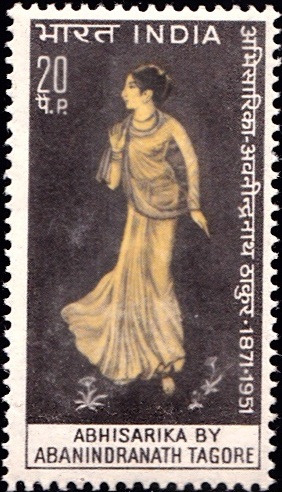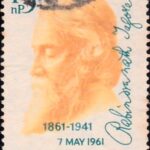
Nandalal Bose 1983
A commemorative postage stamp on the Birth Centenary of Nandalal Basu, an Indian Bengali painter and his painting ‘Pratiksha‘ :
 Issued by India
Issued by India
Issued on Dec 5, 1983
Issued for : The Indian Posts and Telegraphs Department is privileged to issue a commemorative stamp depicting a famous painting of this great artist of India.
Description of Designs : The stamp, designed by India Security Press, shows the painting of Nandalal Bose, titled ‘Pratiksha’. The first day cover shows the portrait of the personality done by Mukul Dey. The cancellation has been designed by Alka Sharma.
Type : Stamp, Postal Used
Colour : Multicolour
Denomination : 100 Paise
Overall size : 4.06 x 2.73 cms.
Printing size : 3.71 x 2.38 cms.
Perforation : 13 x 13
Paper : Unwatermarked adhesive stamp paper
Number printed : 15,00,000
Number per issue sheet : 40
Printing process : Photogravure
Printed at : India Security Press
Name : Nandalal Bose
Born on Dec 3, 1882 at Kharagpur, Munger, Bengal Presidency, British India [now in Bihar]
Died on Apr 16, 1966 at Calcutta, West Bengal, India
About :
- Born on December 3, 1882, the son of Purnachandra Bose and Kshetramani Devi, Nandalal had an innate inclination towards art. Therefore, after his preliminary school education, his parents consented to let him enrol at the College of Art, Calcutta in 1905. He was fortunate to receive the guidance from Abanindranath Tagore who, at that time, was the Vice-Principal. While studying in the College of Art, he won a scholarship, and in 1908 also a prize for his painting Sati Mounting the Pyre. Since then his artistic pursuits and success became companions, providing him respect, admiration and all sorts of worldly and spiritual honours.
- He joined the team of Lady Herringham and assisted in making copies of Ajanta paintings in 1910-11; this brought him into close contact with the greatest masterpieces of Indian art.
- As soon as he finished his college education, the Principal, Percy Brown, invited him to teach at the College of Art; instead he preferred to avail of the facilities to work at Jorasanko offered by Abanindranath Tagore where he came into contact with Ananda Coomaraswami, Sister Nivedita, Okakura and Rabindranath Tagore whose literary manifestations he enjoyed illustrating for years to come. At his insistence, Nandalal joined the Kala Bhavan, Santiniketan in 1920, and remained its Principal until he retired in 1951.
- He was nationalistic to the core and his mature art style constituted traditional, decorative, ornamental and narrative elements, improvised and visually manifested through the linear rhythm, movement, structure and form and, by and large, sombre colours having typical oriental flavour.
- He painted several mythological themes; initially some in the wash technique, to be followed by or simultaneously in tempera and, eventually, adopting or incorporating them in some of his large murals and frescoes. Gradually, his interest widened. Almost every aspect of nature and humble life around attracted him. The influence of Mahatma Gandhi also played an important role. In 1935 he organised an exhibition at the Lucknow session of the Indian National Congress and decorated the Congress Pandals at Faizpur (1937) and Haripura (1937-38) sessions and also painted the famous Haripura Posters.
- His attitude towards his students was very kind and affectionate, advising them to rely on their own inclinations and follow their own path.
- He wrote several articles which constitute the crux of his aesthetic theories and several universities and art institutions awarded him honorary D. Litt. degrees, medals and fellowships. From the Government of India he received the Padma Vibhushan.
- In substance, the vision of Nandalal Bose, who according to a rough estimate, created about ten thousand works of art – including paintings, water colours, drawings, sumies and graphics etc. – was cosmic, and he was completely devoted to his art. Thus, he was both a Silpi-Yogi and also a Karma-Yogi. He died on April 16, 1966.
- (Text by courtesy : Dr. L. P. Sihare, Director, National Gallery of Modern Art, New Delhi).








[…] pioneers such as Rabindranath Tagore, Abanindranath Tagore, Nandalal Bose, Jamini Roy, and Amrita Sher Gil are already legend. Those who have come after them and who have […]
[…] predilections for western art and music squared up to include oriental Arts under the tutelage of Nandalal Bose and Binod Behari Mukherjee, among others. Back in Calcutta, he was employed as a commercial artist, […]